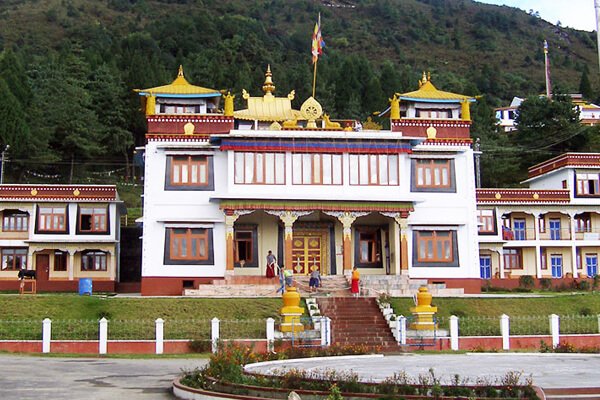Nestled in the picturesque landscapes of Arunachal Pradesh, Bomdila Monastery is a significant spiritual center that attracts both pilgrims and tourists alike. Perched at an altitude of about 2,500 meters in the town of Bomdila, this monastery is a serene enclave amidst the stunning backdrop of the Eastern Himalayas. In this article, we will explore the history, architecture, significance, and the experiences that make Bomdila Monastery a must-visit destination.
Historical Background
Bomdila Monastery, also known as the Gentse Gaden Rabgyel Ling Monastery, was established in the early 1960s. The monastery was built under the guidance of the 14th Dalai Lama and is an important center for the Gelugpa (Yellow Hat) school of Tibetan Buddhism. The construction was influenced by the need for a place of worship and learning for Tibetan refugees and monks who fled to India during the Chinese invasion of Tibet.
The monastery is not just a place of worship but also serves as a cultural hub that preserves and promotes the rich Buddhist traditions and teachings. The serene environment surrounding the monastery makes it an ideal location for meditation and spiritual retreats.
Architectural Marvel
The architecture of Bomdila Monastery reflects traditional Tibetan styles, characterized by vibrant colors and intricate designs. The main structure is adorned with beautiful murals, thangkas (traditional Tibetan paintings), and prayer flags fluttering in the mountain breeze. The monastery complex includes a main prayer hall, living quarters for monks, and several smaller stupas.
One of the highlights of the monastery is its large statue of Buddha, which stands majestically within the prayer hall. This statue, along with various other idols and paintings, represents different aspects of Buddhist philosophy and is a focal point for visitors who come to pay their respects and seek blessings.
Spiritual Significance
Bomdila Monastery plays a crucial role in the spiritual life of the local community as well as visitors from afar. The daily rituals, prayer sessions, and teachings conducted by the resident monks create a spiritual atmosphere that fosters mindfulness and tranquility. Visitors are often invited to join in meditation sessions or attend teachings that delve into Buddhist philosophy and practices.
The monastery also celebrates various festivals throughout the year, which are marked by vibrant processions, prayers, and cultural performances. These events not only attract local devotees but also visitors who wish to experience the rich cultural heritage of the region.
Scenic Beauty
The journey to Bomdila Monastery is as captivating as the monastery itself. The winding roads through lush green hills, tea gardens, and quaint villages provide breathtaking views of the Eastern Himalayas. Upon reaching the monastery, visitors are treated to panoramic vistas of the surrounding mountains, which further enhances the sense of peace and serenity.
The changing colors of the sky during sunrise and sunset create a magical ambiance, making it an ideal spot for photographers and nature lovers. The crisp mountain air and the sound of prayer bells add to the overall spiritual experience, allowing visitors to connect deeply with nature and their inner selves.
How to Reach Bomdila Monastery
Reaching Bomdila Monastery is relatively straightforward, though it does require some planning. The nearest major town is Tezpur in Assam, which is well-connected by rail and road. From Tezpur, one can hire a taxi or take a bus to Bomdila, which is about 150 kilometers away. The drive itself is an adventure, offering breathtaking views of the hills and valleys of Arunachal Pradesh.
For those traveling by air, the nearest airport is in Tezpur, while the nearest railway station is also in Tezpur. From there, the journey to Bomdila provides an opportunity to soak in the beautiful landscapes that define this region.
Visitor Experience
Visiting Bomdila Monastery is a unique experience that transcends mere sightseeing. The atmosphere is imbued with a sense of calm and introspection, encouraging visitors to reflect and meditate. Many travelers spend hours exploring the monastery, observing the monks in their daily routines, and participating in prayer sessions.
The nearby market offers local handicrafts, souvenirs, and traditional Buddhist items, allowing visitors to take a piece of this spiritual journey home with them. The local cuisine, featuring traditional Tibetan dishes like momos and thukpa, adds to the overall experience of immersing oneself in the local culture.
Conclusion
Bomdila Monastery is more than just a religious site; it is a symbol of resilience, culture, and spirituality. For those seeking peace, connection with nature, and a deeper understanding of Buddhist practices, this monastery in Arunachal Pradesh is an invaluable destination. Whether you are a pilgrim, a traveler, or a seeker of spiritual knowledge, a visit to Bomdila Monastery will leave an indelible mark on your heart and soul.
In summary, if you find yourself in Arunachal Pradesh, don’t miss the opportunity to explore Bomdila Monastery. Its breathtaking beauty, rich history, and serene atmosphere await to offer you an unforgettable experience that resonates long after your visit.





Comments